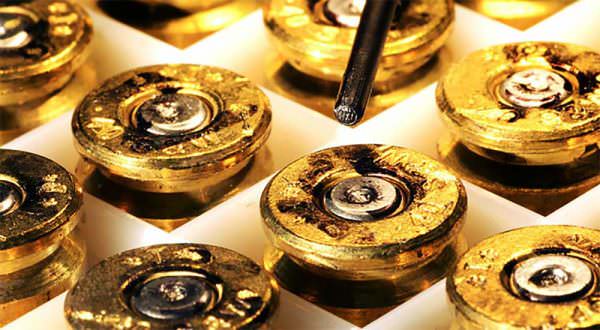
U.S.A. –-(AmmoLand.com)- Proponents of microstamping—the process or stamping an “alpha-numeric code” onto the primer surface of cartridge case when hit by the firing pin—claim the technology “has arrived, but needs legislation to push it through,” according to a new report released this week by the anti-gun Educational Fund to Stop Gun Violence (EFSGV).
“The next step is to enact laws that would require microstamping to be incorporated in all new firearms after a certain date, a coalition spokesperson said during a webinar on the topic,” according to WCMH News in Columbus, Ohio, reporting on a webinar the group held this week to announce its report.
“They also want Congress to require that all semi-automatic pistols in the US are equipped with microstamps for their bullets,” the report stated.
“The report comes as U.S. gun homicides sharply increased in 2020, a troubling percentage of which go unsolved each year,” the gun control group said in a news release. “To maximize the potential of the technology, the EFSGV report recommends that state and federal lawmakers take action by requiring that new semi-automatic pistols come equipped with the invaluable technology.”
Just how this might play into Joe Biden’s gun control agenda isn’t known at this point.
But Larry Keane, senior vice president and general counsel for the National Shooting Sports Foundation, insisted the technology won’t “help solve gun crimes, identify gun trafficking networks and reduce gun violence” as proponents claim.
“There has never been a gun sold anywhere in the world incorporating this patented sole-source technology because it doesn’t work, it can’t work, it will never work,” Keane said via email.
He referred Ammoland News to an NSSF report on microstamping. Buried in that report is an estimate that microstamping would add more than $200 to the cost of a firearm.
On the other hand, the EFSGV quotes a letter from Orrin Gallop, assistant chief, commander of Investigative Services for the Hampton, Va., Police Division in which he contends, “A recovered microstamped shell casing would provide law enforcement immediately with the name of the first purchaser of the firearm. This allows for a more focused investigation, and the first step in the roadmap of how the weapon made its way from the first purchaser to the crime scene. This has the potential to help law enforcement quickly and effectively solve gun-related crimes while limiting negative interactions with law enforcement, especially in minority communities.”
And there is another problem gun control proponents don’t seem eager to address. Microstamping could only work if police recover empty shell casings at a crime scene, and to thwart this, all a criminal would have to do is use a revolver, which does not eject fired empty cases.
The new microstamping threat comes as no surprise to gun rights organizations. Coincidentally, the Citizens Committee for the Right to Keep and Bear Arms, and Second Amendment Foundation, just launched an online effort they call Gun Rights Outreach to Defeat Gun Control Overreach.” Both groups are reaching out to gun owners, providing them with “intellectual ammunition” to defeat the gun prohibition lobby.

When the new microstamping report was announced, Ammoland News reached out to a spokesperson with a simple question: “How many crimes have been solved, with perpetrators arrested, prosecuted and convicted, thanks to microstamping?”
There has been no response so far, and Ammoland can find no reports or anecdotal evidence of a single crime that has been solved thanks to the technology.
Proponents have offered statements filled with promise and potential, but no evidence of results.
“Microstamping is a ready to implement technology that holds tremendous potential to address our current crises of rising gun violence and lack of trust in law enforcement due in part to unconscionably low clearance rates for gun crime investigations, especially in Black communities,” according to Josh Horwitz, Executive Director of the Educational Fund to Stop Gun Violence. “Microstamping is a small technology that will lead to big changes — a reduction in gun violence, less gun trafficking, more trust in law enforcement, and more justice for victims and their families.”
Such rhetoric seems like boilerplate at best. Simply being able to establish that a fired cartridge case can identify the gun from which it came is only part of the process. There’s still no way to identify who fired the shot, and if the particular gun was stolen, then what?
Critics point to the situation in California, where legislation signed last year by anti-gun Democrat Gov. Gavin Newsom requires new handguns sold in the state to have microstamping.
Writing in the San Francisco Chronicle, Ari Riser, a policy analyst for the anti-gun Coalition to Stop Gun Violence (CSGV), insisted the firearms industry must accept the technology while offering no evidence that it will solve or prevent crimes, or reduce so-called “gun violence.”
Conversely, writing in the Lost Angeles Times nearly three years ago, Republican State Assemblyman Matthew Harper recalled that the microstamping issue has prevented gun manufacturers from introducing any new handgun models in the state since 2013. At that time, he noted, “It won’t get illegal guns off the street but will only drive up the cost of handguns made before 2013, making them unaffordable to Californians on a budget who wish to exercise their Second Amendment rights.”
According to one CSVG report, a test conducted in May 2007 “demonstrated the endurance and durability of the technology. During that test, (researchers) fired over 2,500 rounds from a microstamped Smith and Wesson .40 caliber semiautomatic handgun using five different brands of ammunition. Microstamped markings from the firing pin were transferred successfully 97% of the time using both Optical Microscopy and Scanning Electron Microscopy. Additionally, breech face markings transferred to cartridge casings 96% of the time.
“These tests demonstrate the viability of microstamping under even the most extreme conditions,” CSGV said, “but very rarely are handguns fired thousands of times before being used in crimes.”
On the other hand, a report from the Congressional Sportsmen’s Foundation noted, “Two separate research studies have concluded that this technology is ‘unreliable. Research experts from the University of California, Davis, at the behest of the California State Legislature, found microstamping to be ‘flawed’ and concluded that ‘at the current time it is not recommended that a mandate for implementation of this technology in all semi-automatic handguns in the state of California be made.’”
Researchers at UC Davis reported, “the codes on the face of the pin can easily be removed with household tools.”
RELATED:
About Dave Workman
Dave Workman is a senior editor at TheGunMag.com and Liberty Park Press, author of multiple books on the Right to Keep & Bear Arms, and formerly an NRA-certified firearms instructor.

The post New Push for Microstamping; Proponents Claim Technology ‘Has Arrived’ appeared first on AmmoLand.com.
from https://ift.tt/36U4nWP
via IFTTT

No comments:
Post a Comment